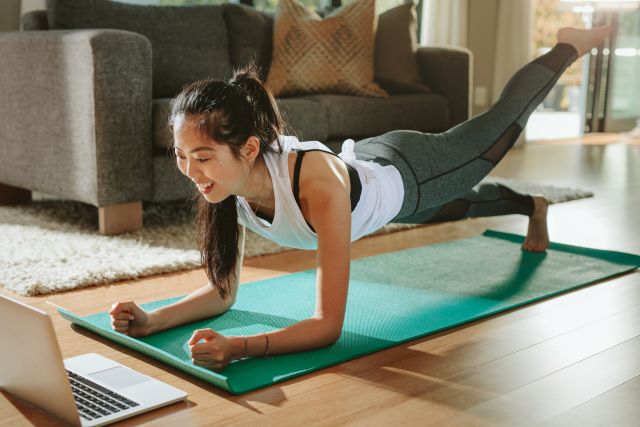When life is busy, getting regular exercise is often one of the first things to fall by the wayside. It doesn't help if finding a safe, comfortable place to work out is difficult.
Many people don't live within close proximity of an affordable gym. Others may not have easy access to parks or green spaces. For others still, neighborhods may be walkable but not always safe for walking.
But making the effort to exercise is worth it. Not only does regular exercise strengthen your body, it can also make you happier. Even a little bit of exercise every day can elevate your mood, reduce stress, and improve your sleep. Experts usually recommend aiming for at least 30 minutes per day, but every little bit counts. If you’re strapped for time, getting your blood pumping and working up a sweat in short 5-minute increments is good for your body and mind.
The good news is that it's possible to devise a simple, effective workout you can do at home. Michael Garrison, PhD, kinesiologist and founder of Hawaii Running Lab in Honolulu, Hawaii, offers insights on ways to exercise indoors that are safe and effective.
Create a time and space
When it comes to setting up an exercise routine, the first thing many people need is structure, Garrison says. He recommends setting a designated time and space to exercise. “It doesn’t have to be a permanent space,” he notes. “It can be in the middle of your family room, but from 10 to 11 a.m., the middle of your family room is the gym.”
You don’t need an entire room or a large space, either. “Basically, you need a footprint the size of a yoga mat and you can get a lot of work done,” Garrison advises. Once you create your time and space, try to focus on workouts that have a goal, such as working up to a certain number of pushups or holding a plank for a minute.
Just remember to be flexible with your guidelines. If you have roommates, kids, or other family members at home, you may not always be able to complete all of the exercises you’d like to. While it helps to set expectations with your family or housemates before you work out, it's important to be open to adjusting your plan as needed.
Use your body weight
If you don’t own weights or gym equipment, no problem. “I think simple body weight moves can be really effective for most people, especially since most of the population doesn't work out on a regular basis,” says Garrison.
Body weight exercises leverage your body mass in different ways to build strength and they don’t require much space. Some moves to try include:
- Push-ups
- Planks
- Lunges (front, side, and reverse)
- Squats
- Jumping jacks
- Leg lifts
- Burpees
- Glute bridges
There are also variations on these exercises. If you have any weaknesses or injuries, you can modify moves where necessary. On the other hand, you can find variations to make your workout a little more challenging. Try holding soup cans in each hand while you squat, then doing sets of biceps curls or shoulder presses when you return to standing. Search the web to find ways to make these bodyweight moves fit with your experience and fitness levels.
Garrison also recommends combining a number of moves into circuits. One way to create a circuit is to pick 8 to 10 exercises, do them for 30 seconds each with a quick rest between sets, then repeat.
Find inspiration online
More and more fitness instructors are teaching their classes online, whether via live streams or recorded videos. “There's a ton of different available workouts online, yoga classes online, everything's getting pushed into that mode, which is fantastic,” says Garrison. You can also find a variety of written workout routines online you can do on your own time.
Consider downloading free apps as well that give you daily plans that will work with your specific needs.
Reach out to friends
Even if you prefer working out solo, it can help your motivation—and accomplishment—to keep friends and loved ones posted about your exercise progress. Consider them your "accountability buddies." Posting on social media about your workouts or texting your highlights to friends can help you meet your goals—and vice versa.
Consider creating a fitness challenge over social media. Many platforms have the option to create private group challenges to keep you and your team members motivated. Or sign up for one of the many monthly fitness challenge available on Sharecare (available for iOS and Android).
You can also pick the same streaming class as a friend and do it together. When you’re done exercising, call or video chat with your buddies to let them know how you did. Talking on the phone can help you feel more connected even if you're not physically in the same place.







